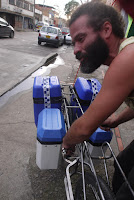 |
'Not One More Death!' Cyclists protest
the recent death of a Bogotá bicyclist. |
Understandably, this year's
Bogotá Bike Week is paying lots of attention to the problem of cyclist fatalities. After all, just
recently two Bogotá bicyclists were killed by accidents on two consecutive days. And so far in 2017, some 45 cyclists have died on Bogotá streets. In contrast, in New York, which has about the same population and also a public bicycles program, about 15 cyclists die each year.
I'm writing this from northern California, where I'm visiting my
 |
A video by the El Espectador newspaper
chronicles the number of Bogot'a cyclists
killed annualy, generally more than 50. |
parents in a suburb east of San Francisco. Bicycling around here makes starkly clear how Bogotá falls short of being a cyclist-friendly city. Unfortunately, the improvements it needs aren't easy.
 |
The 'Cicloruta' on Calle 13, in Bogotá.
Can you see it amidst all those pedestrians? |
Safe, pleasant, useable bike lanes: Bogotá has some of these, and the city is improving. But many Bogotá bike lanes are merely lines painted on sidewalks, where cyclists must dodge around pedestrians, delivery drivers and cars. Other bike lanes have potholes or are blocked by signposts.
In contrast, in northern California, most bike lanes are wide, well-maintained and on streets, where
 |
A California bike lane. Nice -
but where are the cyclists? |
they actually take space away from cars.
 |
A bicyclist (behind taxi/red arrow) tries to cross a
Bogotá intersection blocked by cars which ran the red light. |
Cautious, courteous drivers: Unfortunately, many Bogotá motorists behave as tho they are the only ones with any rights. That's why you see pedestrians waiting interminably at crosswalks.
(When I block the cars to give an old lady a chance to cross, motorists insult me for it.)
Cycling across an intersection often becomes a game of chicken with drivers who run red lights or
 |
Seldom seen in Bogotá: California cars
stop and wait to let a pedestrian
cross a street. |
ignore stop signs and believe that neither laws nor common decency apply to them.
In contrast, here in the Bay Area when I even APPROACH an intersection drivers stop. Is something wrong? I wonder. No, they're waiting for me to cross. Is this out of courtesy, or because they're terrified of getting sued? Does it matter?
Of course, cyclists violate lots of traffic rules. But the general atmosphere of chaos and lack of civility on Bogotá streets makes a cyclist shake his shoulders and ask 'Why obey rules, if nobody else does?'
 |
A Bogotá bus appears to aim its smokey
exhaust at a pedestrian. |
Breathable air: In Bogotá, every time a bus, van or truck passes me, I hold my breath, half expecting to be blasted with diesel smoke. In Bogotá, even many cars belch fumes because they lack a catalytic converter or filters. As any Bogotano knows, in a congested spot, you can literally TASTE the air pollution.
Besides the obvious health impacts, this just makes bicycling unpleasant. In California, which has some of the world's strictest emissions laws, even in congested areas I barely sense fumes at all.
The first of these problems requires an engineering fix, and city planners appear to be improving: All the new bike lanes I've seen are on streets.
But the other two issues involve culture, which is tougher to change. Perhaps less apathetic (and less
 |
New York City bicycling accident
rates have fallen steeply.
(Graph: N.Y. D.O.T.) |
corrupt) transit police could help, as might public relations campaigns. But as long as the every-man-for-himmself credo rules, cycling, driving and walking Bogotá's streets will be dangerous and frustrating.
Yet, for all that, Bogotá has many more cycle commuters than do northern California's suburbs - and perhaps even more than does bike-friendly San Francisco.
That's why I'm becoming convinced that making cycling pleasant and making it popular are two very different - but related - issues. Fixing these troubles will lure onto two wheels only those people who already would like to bicycle, but are afraid to. To get more people to WANT to cycle will require more fundamental social changes.
By Mike Ceaser, of
Bogotá Bike Tours
















































